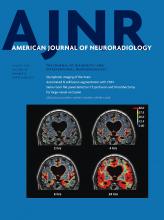Abstract
BACKGROUND AND PURPOSE: Classic findings of intracranial hypotension on MR imaging, such as brain stem slumping, can be variably present and, at times, subjective, potentially making the diagnosis difficult. We hypothesize that the angle between the cerebral peduncles correlates with the volume of interpeduncular cistern fluid and is decreased in cases of intracranial hypotension. We aimed to investigate its use as an objective assessment for intracranial hypotension.
MATERIALS AND METHODS: Brain MRIs of 30 patients with intracranial hypotension and 30 age-matched controls were evaluated by 2 fellowship-trained neuroradiologists for classic findings of intracranial hypotension and the interpeduncular angle. Group analysis was performed with a Student t test, and receiver operating characteristic analysis was used to identify an ideal angle threshold to maximize sensitivity and specificity. Interobserver reliability was assessed for classic findings of intracranial hypotension using the Cohen κ value, and the interpeduncular angle, using the intraclass correlation.
RESULTS: The interpeduncular angle had excellent interobserver reliability (intraclass correlation coefficient value = 0.833) and was significantly lower in the intracranial hypotension group compared with the control group (25.3° versus 56.3°; P < .001). There was significant correlation between the interpeduncular angle and the presence of brain stem slumping (P < .001) and in cases with ≥3 classic features of intracranial hypotension (P = .01). With a threshold of 40.5°, sensitivity and specificity were 80% and 96.7%, respectively.
CONCLUSIONS: The interpeduncular angle is a sensitive and specific measure of intracranial hypotension and is a reliably reproducible parameter on routine clinical MR imaging.
- © 2019 by American Journal of Neuroradiology







